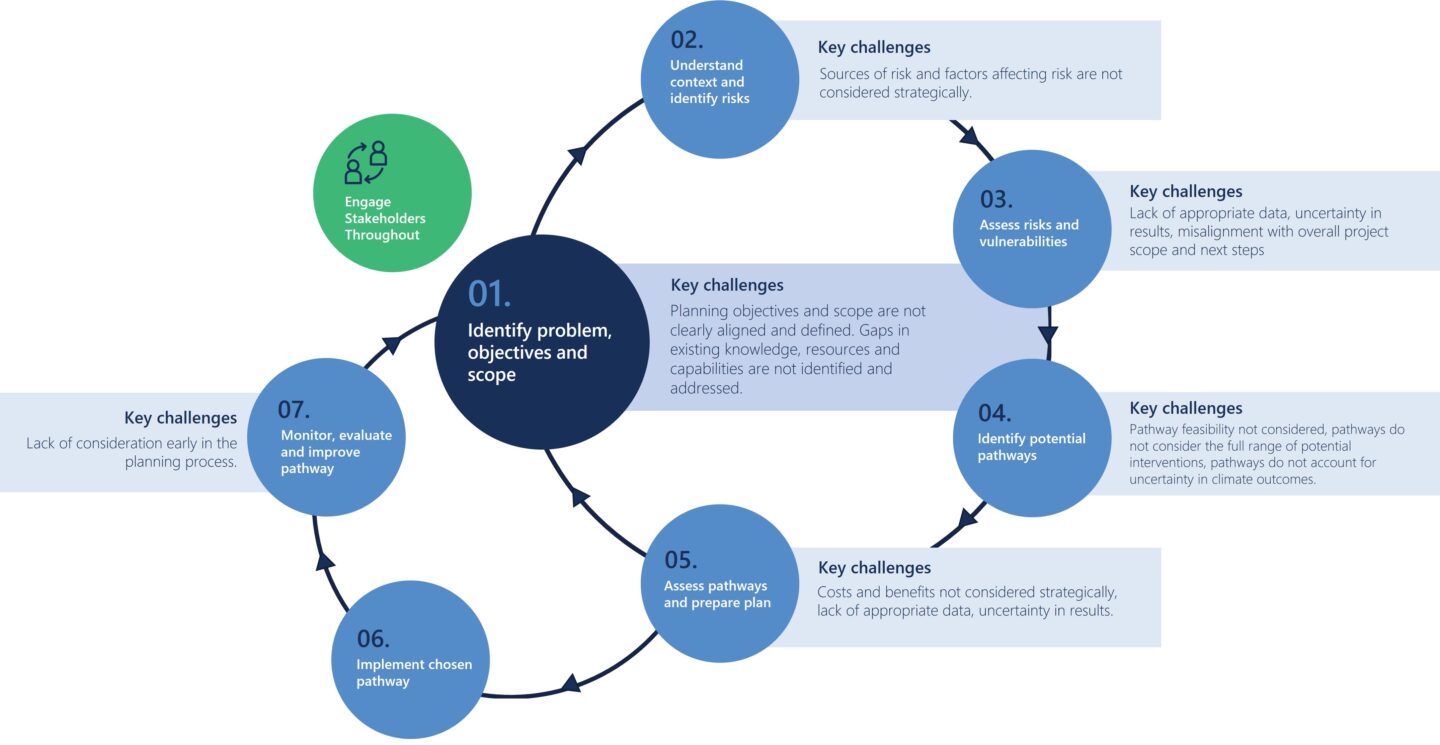Effective adaptation planning is vital to addressing the clear and inevitable effects of climate change. However, the current implementation of adaptation measures is slow and disjointed. Without effective adaptation action, there will be significant consequences for built infrastructure, supply chains, environmental systems and the welfare of our communities. Aither undertook research to understand key challenges faced by public and private organisations undertaking adaptation planning that could be preventing or delaying implementation of effective adaptation measures. We reviewed 27 adaptation guidelines, frameworks and tools, and numerous case studies from across Australia and internationally. Our review, summarised below, identified common challenges and gaps in existing guidelines and processes, proposed practical solutions for these issues and developed a best practice planning framework.
Common adaptation planning challenges
Delivering effective adaptation solutions requires good adaptation planning. However, adaptation planning process can be difficult to manage, leading to planning delays or sub-optimal or maladaptive outcomes. Aither’s review identified five common challenges faced by adaptation planning practitioners that affect planning success:
- Planning processes are not fit for purpose.
- Planning processes are not flexible and do not adapt to new information or setbacks.
- Decision-makers avoid making decisions when outcomes are uncertain.
- Planning does not focus on the appropriate climate risks, adaptation pathways, costs and benefits.
- Practitioners do not meaningfully engage with community, planning partners, decision-makers, and other key stakeholders.
Executing a fit for purpose planning process is the most significant and common challenge affecting planning success. This challenge may be driven by overly prescriptive guidelines, lack of adequate planning preparation, or a lack of adequate expertise or engagement during planning preparation.
Existing adaptation planning guidelines – Insights and gaps
Existing planning guidelines provide useful insights for undertaking effective adaptation planning and managing common challenges. For example, most planning guidelines reviewed by Aither emphasise that adaptation planning should be treated as a continuous process and should be updated regularly as new information arises and circumstances change. Most existing guidelines also emphasise the importance of engagement with community and note that decision-makers and practitioners need to be willing to commit to decisions with imperfect information.
Existing adaptation planning guidelines often contain one or more common gaps:
- an assumption that the decision to proceed with adaptation planning has already been made and inadequate consideration of an organisation’s readiness to plan
- inadequate consideration of an organisation’s readiness to fund and implement an adaptation pathway or intervention early in the planning process
- inadequate consideration of cross-sector risks or interactions between different climate risks
- a lack of detailed guidance about preferred approaches to risk assessment and pathway assessment, particularly when guidelines relate to a specific adaptation program or fund
- a lack of guidance on how to determine when it is appropriate to continue to seek further stakeholder input and when it is appropriate to acknowledge differences and continue to move forward with planning
- a lack of recognition of the importance of clear, plain and concise communication between planning partners and to other key stakeholders.
A best practice approach to adaptation planning
Aither has developed a tailored adaptation planning framework that recognises and responds to common adaptation planning challenges and gaps. This framework can be applied to a range of sectors, levels of government, and geographical contexts. The framework describes seven steps for effective adaptation planning, the relationship between these steps, and outcomes that should be achieved at each step. When using the framework, organisations should undertake steps 1 to 5 as many times as required before moving to implementation (step 6) and monitoring and evaluation (step 7). Defining clear objectives and scope (step 1) is central to the planning process and should be revisited throughout steps 2 to 5.

This framework supports a flexible and strategic structure for adaptation planning. The framework emphasises the importance of establishing planning objectives and scope early on, but also provides space for iteration as knowledge and understanding evolves.
Organisations can manage common challenges and gaps using our framework in combination with a range of mitigation strategies. Six key strategies have been identified to support positive adaptation outcomes. These strategies are most effective when they are employed from the start of an adaptation planning process, although they are still beneficial if they are implemented partway through or as challenges arise.
- Define the purpose, objectives, scope of the process early and revisit them consistently.
- Plan to undertake each step of the process multiple times.
- Get the right people in the room at the right time for the right reasons.
- Utilise recognised approaches for managing uncertainty and poor data.
- Ensure decision-makers and key stakeholders are comfortable with decision-making approaches.
- Use a funnel approach to prioritise key climate risks and adaptation pathways, costs and benefits.
In addition to these strategies, we recommend organisations assess their readiness to undertake adaptation before planning begins by identifying and addressing key capacity, capability, knowledge, and governance constraints.
Aither will provide more details about the adaptation planning framework, common planning challenges and strategies to overcome these challenges in a future webinar. For more information on Aither’s adaptation planning guidance, stay in touch for information about our webinar or contact Associate Director Martijn Gough. We welcome any feedback about specific planning steps, challenges or strategies which are of interest to organisations undertaking adaptation planning.
Aither would like to acknowledge the input and guidance into this review provided by Stephen Dovers and Anthony Boxshall.
Download the PDF version


